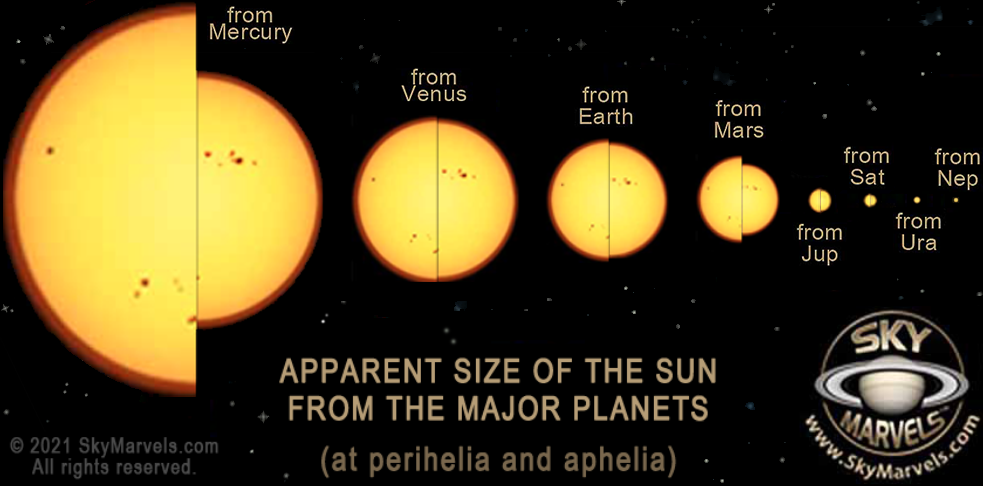

Because the major planets have orbits of vastly different dimensions, the Sun's apparent size in their respec- tive skies varies greatly from planet to planet. Above we see the relative apparent sizes of the Sun as viewed from the perihelion and aphelion of each of the major Solar System bodies. Though most major planets have nearly circular orbits and the Sun's apparent size does not fluctuate appreciably in each one's own sky, Mercury and Mars are the exceptions. With the greatest orbital eccentricity of any of the major planets, Mercury sees the Sun's diameter vary in its sky by almost 50% over the course of each orbit! And though Mars does not see the Sun's diameter vary by such a startling extreme, the orbital eccentricity of the "Red Planet" is still large enough to play a significant role in the Martian seasons!
Many people are surprised to find that the Sun looks so small from the Gas Giants. But the Solar System is immense! Distant Neptune orbits some 30 times farther from the Sun than does Earth! Therefore the Sun's apparent diameter in Neptune's sky is only 1/30th of its diameter perceived from our home planet's location in the inner solar system. This means that each square meter of Neptune's surface receives light only about 1/900th (1/30th x 1/30th) as intense as a comparable square meter of Earth's surface!
Also check out the Relative Intensity of Sunlight at the Planets. Since the human eye can adapt so well to varying light levels, you may be surprised by what "daylight looks like" as you venture further out in the Solar System.
Home Intro News Gallery Sky-Gifts Bonuses Tips
Learning Ctr Help Links Credits Legal Contact Us
© 2007-
by Gary M. Winter. All rights reserved.
Interested in political cartoons and humor?
Check out The HIPPLOMATS™.
SkyMarvels, Sky Marvels, SkyMarvels.com, SUN'S APPARENT SIZE FROM THE MAJOR PLANETS, How big does the Sun look from the other planets?, celestiaforall, CELESTIA, astronomy, space, simulations, animations, downloadable astronomy posters, stars, planets, Inner Planets, Outer Planets, Inferior Planets, Superior Planets, moons, asteroids, comets, Oort Cloud, galaxy, galaxies, Milky Way, Andromeda, globular clusters, binaries, quasars, black holes, supermassive black holes, telescope, telescopes, planetarium, software, freestuff, satellites, add-ons, addons, scripts, eclipses, Solar Eclipses, Lunar Eclipses, Solar Eclipse Finder, Lunar Eclipse Finder, mutual eclipses, transits, occultations, Solar System, CELES-TOOLS, celeSTARrium, CELX, CELX programming, Freebies, multiple views, atronomical unit, light year, parsec, meteors, meteor showers, Perseids, Geminids, Leonids, barycenter, time, Time Zones, tides, alignments, conjunctions, oppositions, seasons, apogees, perigees, aphelion, perihelion, Earth, Luna, Mercury, Venus, Mars, Jupiter, Galilean Moons, Io, Europa, Ganymede, Callisto, Saturn, Titan, rings, Uranus, Neptune, Triton, E-MSpectrum, electromagnetic spectrum, astronaut, equinoxes, solstices, precession, rotation, spin, inclination, tilt, Ecliptic, orbits, ellipse, parabola, hyperbola
